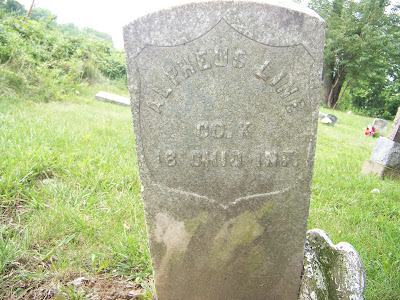See
part 1 right here.
After the repulse of the Rebels at Knoxville, the 16
th Kentucky and John Clark remained in eastern Tennessee, fighting in the battle at
Mossy Creek. More importantly, though, it was here that members of this unit re-enlisted in the Union Army on December 27, earning the much-desired title of “Veteran Volunteers.” This meant the regiment had met the quote of re-enlisting required to earn that designation, a sign that the men were committed to fighting until the war’s end
According to information in his military papers, John had to officially muster out of the 16
th Kentucky and then re-enlist into the 16
th Kentucky Veteran Volunteers. At this time, he was owed $8.48 in pay, with another $100 due in bounty money.
On the re-enlistment paper containing his agreement to re-enlist, John simply left an “X” as his mark where his signature was requested. This form also included a section to be signed by a recruiting officer, with one of the pre-printed lines stating: “he was entirely sober when enlisted.” I guess this was an important point to record when trying to meet the various quotas the regiments and states faced.
Even better than the Veteran Volunteer title, however, was the 30 day furlough which came as a reward for re-enlistment. During early 1864, the soldiers of the 16
th Kentucky took advantage of this precious time off, and John’s return to Bracken County must have been a joyful occasion, though his paperwork does not show exactly when he was back home.
“Time flies when you’re having fun,” however, and no doubt that is how these men felt about their furloughs. By mid-April, they had been ordered to Camp Nelson in Central Kentucky, but soon thereafter headed back through Knoxville, before joining with General William Sherman’s forces in Red Clay, Georgia where they joined what would become Sherman’s
Atlanta campaign.
The 16
th Kentucky took part in several of the skirmishes and battles of this campaign over the next few months, including Rocky Face Ridge, Resaca and New Hope Church, among others.
On May 14, Colonel J.W. Reilly noted in his report that during the battle at Reseca: “
The Sixteenth Kentucky Veteran Infantry…being in front line of the brigade, passed up the slope over the crest and the rifle pits without a perceivable halt in their lines more than was unavoidable from the character of the ground. The front line of the brigade moved to crest of the ridge immediately in front of the enemy’s batteries, located in their second line of works. The brigade, particularly the first line, was exposed to a very severe fire of musketry and canister after passing first the enemy’s pits, while advancing to second crest and during the greater portion of the time they held the position.”
In another report, he noted that on May 22, several regiments, including the 16
th Kentucky “
were ordered to and did proceed to the Etowah Mills, some five miles from camp, and destroyed the mills containing large quantities of corn, flour &c., and other buildings connected therewith, skirmishing slightly with the enemy while in vicinity of river.” Not only was this a fight against the enemy army, but, now also against anything, such as food supplies, that might aid the Confederacy.
On June 2, the brigade moved to Brownlow’s Hill, and the 16
th Kentucky was among three regiments that “
charged across the creek and field, and drove the enemy into their works on crest of hill, occupying and holding possession of the position from which enemy were driven, constructing temporary works during the night.” (Even after winning a fight, they got no rest, as that night was spent building defenses against a possible enemy attack.)
The 16
th remained busy, as on the 19
th of June, they “
made a reconnaissance on Marietta road some two and a half miles, driving enemy’s skirmishers rapidly across Noyes’ Creek on that road, capturing some 19 prisoners.”
The report from Major John White of the 16
th Kentucky provided more details, including a July 14
th storm “
during which a tree was blown down and Adjutant Dudley was instantly killed,” showing that battle was not the only danger these brave men faced.
As the weeks passed, the campaign continued.
On August 6, the 16
th Kentucky “was placed on the right with orders to drive a body of the enemy” and “this regiment fully obeyed their orders, and rendered a very important service in protecting the main column” from enemy artillery fire which had been annoying the Union forces, according to Colonel Reilly.
On September 1, Major White noted: “
our brigade tore up considerable of the railroad” before moving towards Jonesboro.
The Confederates finally abandoned Atlanta on September 1st.




















